LIB 7.6%
Incumbent MP
- Wilson Tuckey, Member for O’Connor since 1980.
- Barry Haase, Member for Kalgoorlie since 1998.
Geography
North of Western Australia. Durack covers a majority of Western Australia’s landmass, stretching from the northern Wheatbelt outside of Perth, covering the coast all the way to the Northern Territory border. Major towns include Geraldton, Broome and Port Hedland.
Redistribution
Durack is a new seat, created for the 2010 election. Prior to the redistribution, the seats of Kalgoorlie and O’Connor covered the great majority of Western Australia’s land mass. O’Connor formed a ring around the heavily-populated part of Western Australia, stretching from Albany on the southern coast of Western Australia, all the way to Geraldton, on the Indian Ocean coast north of Perth. The large landmass east of O’Connor was contained in the seat of Kalgoorlie, the largest single-member constituency by landmass, at least in a western democracy, covering over 2.2 square kilometres. Kalgoorlie covered towns such as Kalgoorlie, Broome and Port Hedland.
The redistribution saw Kalgoorlie abolished, and O’Connor redrawn from a ring seat into a massive southern seat, with the northern parts of Kalgoorlie and the former O’Connor formed into the new seat of Durack.
The former seat of Kalgoorlie was held by the Liberal Party by 2.6% in 2007. The new seat has a margin of 7.6%, with the ALP’s stronger areas broken between Durack and O’Connor.
History – O’Connor
O’Connor was founded in 1980. It has been held by a single MP for the last three decades. The seat was won in 1980 by Wilson Tuckey.
Tuckey served on the Liberal frontbench from 1984 to 1989 and again from 1993 to 1996. He served as a minister in the Howard government from 1998 to 2003.
Tuckey has developed a reputation as a maverick and a member of the Liberal Party’s far right. The ALP has never threatened Tuckey’s hold on the seat, but in 2007 he was considered at risk of losing. The Nationals gained a large swing and came within 3% of overtaking the ALP, while Tuckey’s primary vote fell below 50%.
History – Kalgoorlie
Kalgoorlie was an original federation electorate. The seat regularly swung back and forth between the ALP and the Liberal Party.
Free Trade candidate John Kirwan won Kalgoorlie in 1901. He lost the seat in 1903. Kirwan later served as an independent member of the Western Australian Legislative Council from 1908 to 1946.
The ALP’s Charles Frazer won Kalgoorlie in 1903. He served as a minister in the second Fisher Labor government from 1910 until 1913, when the government was defeated. Frazer died six months after the 1913 election.
The ensuing by-election was won by Hugh Mahon. He had previously held the seat of Coolgardie from 1901 to 1913, when the seat was abolished, and he failed to win election for the new seat of Dampier. Mahon had been a minister in the Watson government and the first Fisher government.
Mahon again served as a minister in the third Fisher government in 1914, and served as a minister until the Labor Party split in 1916, when he remained loyal to the party. Mahon lost the seat in 1917 to Edward Heitmann of the Nationalists, but won it back in 1919.
In 1920, Mahon made comments attacking the British Empire and its policies in Ireland after the death of a hunger-striking Irish nationalist. In response, Prime Minister Billy Hughes moved a motion in the House of Representatives to expel Mahon for sedition, disloyalty and conduct “inconsistent with the oath of allegiance”, and Mahon was expelled. He remains the only member of the federal Parliament to be expelled.
Mahon suffered a swing at the ensuing by-election, losing to Nationalist candidate George Foley.
Foley lost in 1922 to the ALP’s Albert Green, a former state MP. He served first as Minister for Defence and then Postmaster-General in the Scullin government, and held the seat until his death in 1940, shortly after the 1940 election.
The 1940 by-election was won by the ALP’s Herbert Johnson. He was appointed to the Chifley government’s first ministry in 1945 after the death of Prime Minister John Curtin, and he served in the ministry until the government’s defeat in 1949.
Johnson retired in 1958, after losing Labor endorsement, partly due to his criticism of ALP leader HV Evatt. At the 1958 election, the Liberal Party’s Peter Browne won the seat on DLP preferences, despite the ALP’s Fred Collard leading on primary votes.
Browne lost to Collard in 1961. Collard held Kalgoorlie until his defeat at the 1975 election, losing to Liberal candidate Mick Cotter.
Cotter held the seat at the 1977 election before losing to the ALP’s Graeme Campbell in 1980.
Campbell, while being an ALP member, was on the far right of the party, supporting uranium mining and opposing sanctions on apartheid South Africa and Aboriginal land rights. In the early 1990s he flirted with anti-immigration groups, and his constant differences with the Labor government saw him expelled from the ALP in 1995.
Campbell won re-election in 1996, gaining Liberal preferences to help defeat the second-placed Labor candidate.
Campbell was one of five independents in the new parliament in 1996, alongside two disendorsed former Liberal MPs from Perth, progressive NSW independent Peter Andren, and ex-Liberal Pauline Hanson.
In 1996 he founded the Australia First Party, along similar lines to the One Nation party formed by fellow independent MP Pauline Hanson in 1997. Campbell’s party failed to grab the public’s imagination in the same way as Hanson’s, and his party was largely overshadowed by One Nation. He came third in Kalgoorlie in 1998, when Liberal candidate Barry Haase topped the primary vote with barely 28%. Incredibly, Campbell’s 22.8% and the 8.4% for One Nation would have produced a combined vote greater than either Liberal or Labor.
Campbell later went on to contest the Senate in 2001 for One Nation, and run for Kalgoorlie again in 2004 and the Senate in 2007, but never came close to winning again.
Haase won Kalgoorlie in 1998 with only a 2.1% margin over the ALP. This grew to over 6% in 2004, but dropped back to 2.6% in 2007.
Candidates
- Lynne Craigie (Nationals)
- Barry Haase (Liberal) – Member for Kalgoorlie since 1998.
- Shane Hill (Labor)
- Mac Forsyth (Christian Democratic Party)
- Julie Matheson (Greens)
- Jane Foreman (Family First)
Political situation
At the 2007 election, the Liberal Party was threatened in O’Connor by the Nationals, and in Kalgoorlie by the ALP. The new seat of Durack is held by a much larger margin over the ALP. The Liberal candidate should have no trouble winning the seat.
2007 result – O’Connor
| Candidate | Party | Votes | % | Swing |
| Wilson Tuckey | LIB | 34,876 | 45.85 | -7.40 |
| Dominic Rose | ALP | 15,541 | 20.43 | +1.86 |
| Philip Gardiner | NAT | 13,459 | 17.69 | +8.25 |
| Adrian Price | GRN | 5,188 | 6.82 | +0.09 |
| Mac Forsyth | CDP | 2,235 | 2.94 | +0.12 |
| Ross Paravicini | ON | 1,214 | 1.60 | -2.75 |
| Michael Walton | IND | 1,128 | 1.48 | +1.48 |
| Stephen Carson | FF | 991 | 1.30 | +1.30 |
| George Giudice | IND | 986 | 1.30 | -1.46 |
| Darius Crowe | IND | 237 | 0.31 | +0.31 |
| Judy Sudholz | CEC | 212 | 0.28 | -0.22 |
2007 two-candidate-preferred result – O’Connor
| Candidate | Party | Votes | % | Swing |
| Wilson Tuckey | LIB | 50,625 | 66.55 | -3.84 |
| Dominic Rose | ALP | 25,442 | 33.45 | +3.84 |
2007 result – Kalgoorlie
| Candidate | Party | Votes | % | Swing |
| Barry Haase | LIB | 31,565 | 48.14 | +2.68 |
| Sharon Thiel | ALP | 26,653 | 40.65 | +8.73 |
| Robin Chapple | GRN | 4,045 | 6.17 | -0.16 |
| Derek Major | ON | 1,075 | 1.64 | -0.69 |
| Ross Patterson | CDP | 962 | 1.47 | +0.19 |
| Ian Rose | FF | 820 | 1.25 | +1.25 |
| Ian Burt | CEC | 275 | 0.42 | -0.07 |
| Charles Dalton | LDP | 176 | 0.28 | +0.27 |
2007 two-candidate-preferred result – Kalgoorlie
| Candidate | Party | Votes | % | Swing |
| Barry Haase | LIB | 34,474 | 52.58 | -3.72 |
| Sharon Thiel | ALP | 31,079 | 47.42 | +3.72 |
Booth breakdown
O’Connor covers 48 local government areas. Booths have been divided into five areas. From north to south: Kimberley, Pilbara, Gascoyne, Mid West, Wheatbelt.
The ALP won a majority in both the Pilbara and the Kimberley. The Liberal Party won a small majority in Gascoyne, and larger majorities in the Mid West and the Wheatbelt (where they won almost three-quarters of the vote).
It is not possible to determine where votes were cast when they were cast away from ordinary polling booths, so the following table shows the ‘other votes’ for the old seats of O’Connor and Kalgoorlie.
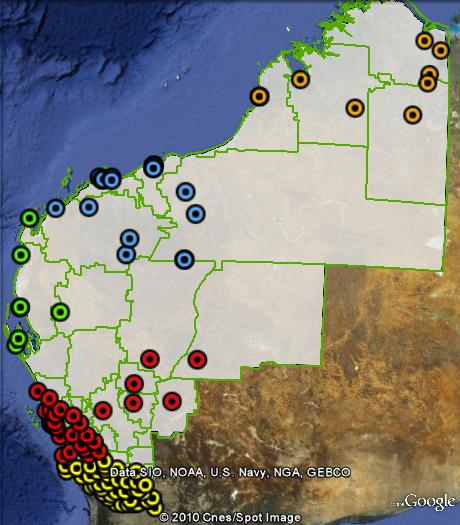
| Voter group | GRN % | LIB 2CP % | Total votes | % of ordinary votes |
| Mid West | 4.97 | 62.85 | 22,137 | 37.83 |
| Pilbara | 5.76 | 43.07 | 14,506 | 24.79 |
| Wheatbelt | 3.26 | 74.91 | 9,884 | 16.89 |
| Kimberley | 9.45 | 45.03 | 8,489 | 14.51 |
| Gascoyne | 6.26 | 53.52 | 3,496 | 5.97 |
| Other votes (Kalgoorlie) | 7.01 | 57.12 | 13,665 | |
| Other votes (O’Connor) | 7.55 | 57.12 | 13,165 |
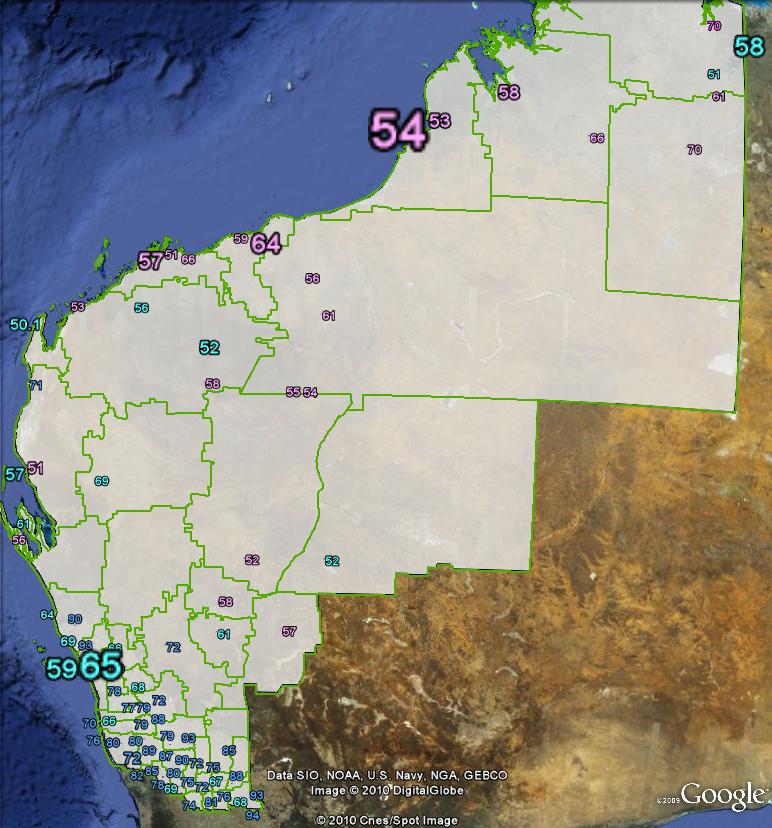
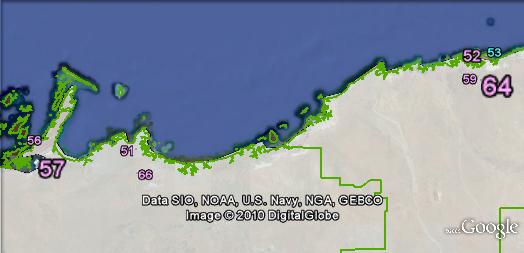
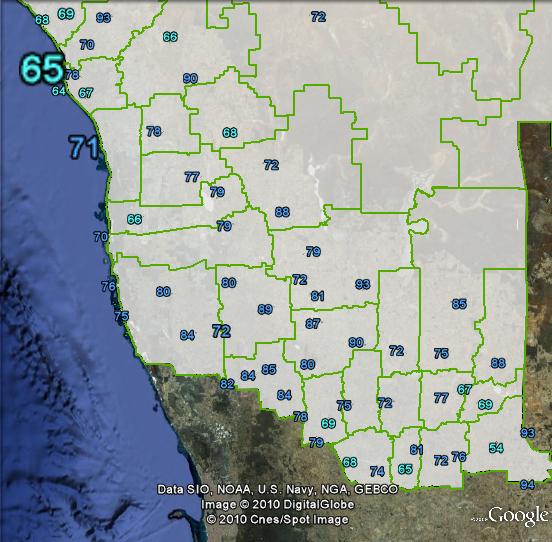
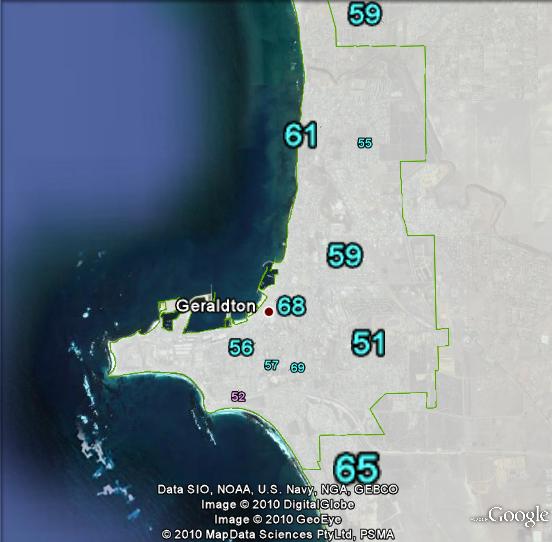


Family First are running Jane Foreman, a former Geraldton councillor.
Hah – Labor are running Shane Hill, who was member for Geraldton over the time of the Gallop / Carpenter government. He got on the wrong end of the one vote one value redistributions, which turned his seat notionally Liberal, and then it swung to the Libs so it’s now safe for them. Looks like Labor aren’t running dead here, then, so they’ll probably come second and the Libs will have an easy win.
The strong Lib vote in the Wheatbelt will get Haase past the line easily, not to mention the mining tax revolt up in the PIlbara!
Having said that the Nationals could be a roughie??
The Liberals don’t have a strong vote in the wheatbelt, Labor has a pathetically weak one. It’s good for the Liberals as long as the Nationals don’t play… if they are, it’s different ball game, especially with a redistribution putting half the voters in a different seat. I doubt too many wheatbelt folk know much about Barry Haase. Meanwhile, the Nats proved in 2008 they can do well up north, and their candidate’s from Newman. It’ll be interesting watching the way the different parts of the electorate behave.
The Nats are a possible roughie in the same way as a few recent state results: Lib held, but won by the Nats coming second and winning on ALP preferences (as opposed to the rock solid margins sitting members tend to get over the Liberals). The Nats could even do it from a narrow third if they get preferences from the christian parties, but with a reasonably well-known candidate I can’t see Labor slumping that much. I’ll tip Libs by 5-10% over ALP.
Fun fact: the Shire of Murchison (the empty space north-east of Geraldton) has no polling booths, due to there being no towns. Population: 114, most of whom live on sheep stations. It’s the only LGA in Australia without a town, so presumably also the only one without a polling booth. In NSW or SA, areas like that aren’t even divided up into councils, instead just calling the lot ‘unincorporated regions’ or similar. I wonder if we’ll ever do that.
Labor are putting Libs ahead of Nats on their HTV card in Durack:
http://www.watoday.com.au/federal-election/labor-liberal-doubleteam-riles-nats-20100811-11zm9.html
And it just wouldn’t be a whinge about preferences without somebody completely misunderstanding how they work. Nats state president Colin Holt, paraphrased by WA Today:
So if they’ll be unhappy with that then they’ll be preferencing the Nats instead… it ain’t hard. Holt could’ve even turned it into a pitch at Labor voters for their #2 vote.
Yeah I was wondering about that entire LGA with no booths! I’m pretty sure it would be the only one in the country, excluding some indigenous councils which may only have mobile polling booths.
My prediction: With Labor preferencing Libs there’s no hope for the Nats. Liberal retain, 2-3% swing to them.